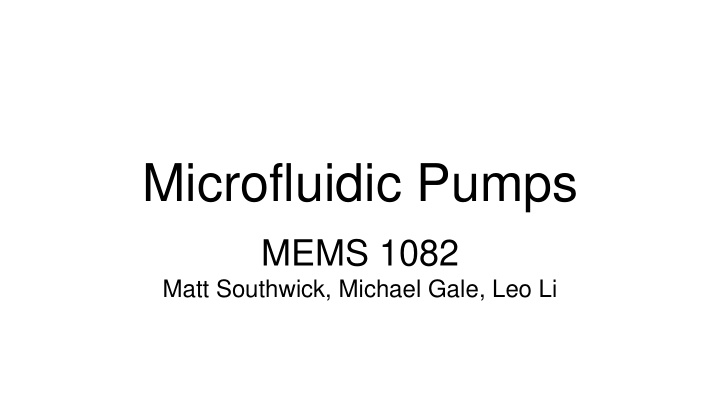



Microfluidic Pumps MEMS 1082 Matt Southwick, Michael Gale, Leo Li
Pump Mechanisms ● Piezoelectric ● Capacitive ● Thermal
Piezoelectric Microfluidics Pump Theory ● Piezo coupled to mechanical reservoir ● Resticition of chamber causes volume change E.Q. Li,Q. Xu,J. Sun,J.Y.H. Fuh,Y.S. Wong,S.T. Thoroddsen . “ Design and fabrication of a PET/PTFE-based piezoelectric squeeze mode drop-on-demand inkjet printhead with interchangeable nozzl e.” Sensors and Actuators A: Physical. Elsevier. September 2010.
Mechanism of operation ● Controlled electrical signals cause controlled diaphragm motion ● Fluid forced from reservoir by deformation Feng, Zhang. “Piezoelectric MicropumDrive Rrference Design. Microchip Technology Incorporated.
Device Fabrication ● Reservoir Micromachining ● Semiconductor fabrication techniques for diaphragm Perçin G, Khuri- Yakub B. “Micromachined droplet ejector arrays for controlled ink - jet printing and deposition.” Review of Scient ific Instruments. November 2001.
Common Uses and Performance ● Bio Pumps ● Precision pumping ● Volume flow potential ● Precision of control ● Cost ● Power Consumption https://www.servoflo.com/micropumps/mp6
Thermal Microfluidic Pump ● Electrical energy to thermal energy ● Heat transfer into liquid and generates bubble ● Only works with liquids that evaporate quickly when heat transfers in
Mechanism of Transduction
Fabrication ● Microfabrication Technology ○ Photolithography ○ Deposition ○ Etching ○ Oxidization ● Layer by Layer
Characterization ● Location of heating element ○ Roofshoot ○ Edge shoot ● Geometry ○ Nozzle Length ○ Cartridge Volume
Capacitive Microfluidic Actuator ● Detection via capacitance change ○ Only channel capacitance change is significant ● Actuation via electrowetting
Detection ● Position ○ Saturation Capacitance indicates max radius ● Velocity ○ Position vs t2 - t1 ○ Plate dimensions used ● Volume ○ Magnitude of Saturation Capacitance and sensitivty
Transduction ● Droplet drawn across channel via electrowetting ○ Electrodes are hydrophobic when unloaded ○ Wetting potential applied to draw droplet to next electrode ● Previous plate becomes hydrophobic as next plate becomes hydrophilic
Fabrication 1. Spin Coating 2. Lift Off (lithography) 3. Magnetron Sputtering
Uses ● Chemical/Biochemical precise volume delivery/mixing ● Printing ● Touch Sensor (liquid electrode)
Summary ● Piezoelectric micro pump - High precision with high cost ● Thermal micro pump - Easy fabrication with lower precision ● High precision, does not alter fluid - low force
Citations ● https://www.elveflow.com/microfluidic-tutorials/soft-lithography-reviews-and-tutorials/introduction-in-soft-lithography/pdms- membrane-thickness-of-a-spin-coated-pdms-layer/az4562-spin-coating/ ● https://loolab.chem.ucla.edu/research/proteomics.html ● https://www.dentonvacuum.com/products-technologies/magnetron-sputtering/ ● https://en.wikipedia.org/wiki/Lift-off_(microtechnology)
Recommend
More recommend